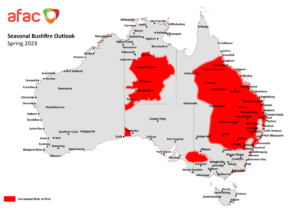Overview 2023: AUSTRALIA
AGENCIES BRACE FOR SUMMER OF EXTREMES
BY DAVID BRUCE
Across southern and eastern Australia, where most of the population resides, a strong La Nina has contributed to three consecutive years of below average fire seasons. Flood and storm response has been the main recent focus with fire and land management staff and volunteers heavily involved in incident management, response, public alerts, rescue, and clean up –much of it in the early days also combined with a significant contribution to pandemic response.
By the fourth quarter of 2023, the Bureau of Meteorology had declared that El Niño and a positive Indian Ocean Dipole (IOD) were underway, the two climate drivers likely to lead to a warmer and drier spring and summer.
With the ground still moist or barely dry from La Nina rain, southern and eastern Australia again prepared for a busy fire season. The high rainfall was accompanied by grass growth particularly in some areas and hampered attempts to fully complete prescribed burning plans over the last few years. The fire agencies were primed to respond, and for the first time, in late September, the Australian government held a National Bushfire Preparedness Summit with around 250 crisis management, response and recovery specialists from governments, industry, research, community and the not-for-profit sector.
Fire is an almost year-round occurrence in Australia with the fire season moving in a predictable north to south direction from the Top End around June to Tasmania up until March. But recently the rules have been ignored – one week in September this year saw large destructive bushfire activity in the Barkly region of central Northern Territory, coastal Central Queensland and in Tasmania, which is in the southernmost region of Australia.
Australia’s climate influences have shifted significantly over 2023, making predictions difficult. Following above average rainfall experienced during consecutive La Niña years, the Bureau of Meteorology predicted a switch to higher chances of above average temperatures and below average rainfall for almost the entire country. However, while the temperatures were high so was the spring rainfall with serious flooding in many regions, complicating and delaying fire preparations.
With the introduction of the new Australian Fire Danger Rating System (AFDRS) at the end of 2022, Australia commenced its first full bushfire season with a nationally consistent way to predict and communicate fire danger. The AFDRS replaced the 60-year-old McArthur-based system.
The AFDRS uses eight fire behaviour models rather than the two used by the McArthur system of fire danger. The eight vegetation type models comprise forest, grassland, savanna, spinifex, shrubland, Mallee heath, buttongrass and pine.
Each of these fire behaviour models include modifications to expand their use to 22 national fuel types. Using these models and fuel types, AFDRS can better account for the diversity of vegetation types across Australia.

The fire danger ratings have been simplified to four levels from six: Moderate (green); High (yellow); Extreme (orange); and Catastrophic (red).
For many Australian firefighters, an early start to the fire season had an international flavour. With the final 27 personnel returning home from Canada early September, the largest ever international deployment of Australasian personnel to Canada was completed.
Since late May, 746 personnel from all jurisdictions across Australia, as well as New Zealand, were deployed to Alberta, British Columbia and the Northwest Territories. Representing fire, land management and state emergency service agencies, the Australasian personnel have been fulfilling arduous firefighter, incident management, aviation management and supervision roles. Many of the personnel were deployed across remote and challenging areas in Canada including Slave Lake, High Level and Peace River, in Alberta, and Fort Smith, in the Northwest Territories. Thousands of international resources from the United States, Central and South America, Europe and South Africa also assisted wildfire suppression efforts.
As Australians watched the extreme wildfires of Canada, Hawaii and across southern Europe in the hot northern hemisphere summer, they hoped their extra efforts at preparation would be enough.
The federal minister for emergency management, Murray Watt, said recent history had raised the importance of national co-ordination and support:
“But we’re conscious that this is shaping up to be the first significant fire season since Black Summer (2019-20), so we’re doing everything we can to be as prepared as possible at every level.”
 David Bruce is the communications director with Natural Hazards Research Australia. Prior to that he held the same position at the Bushfire and Natural Hazards CRC and its predecessor, the Bushfire CRC. Bruce led the development and implementation of the branding and communications in the start-up phase of the centre and leads a small team managing publications, online media, stakeholder relations, media relations and events. Bruce completed two terms on the IAWF board and remains on the communications committee. Bruce is a member of the Public Relations Institute of Australia. His working life began as a journalist and news editor with Melbourne’s daily broadsheet The Age and News Limited’s community newspapers, and later as the communications and media manager at Monash and Deakin universities.
David Bruce is the communications director with Natural Hazards Research Australia. Prior to that he held the same position at the Bushfire and Natural Hazards CRC and its predecessor, the Bushfire CRC. Bruce led the development and implementation of the branding and communications in the start-up phase of the centre and leads a small team managing publications, online media, stakeholder relations, media relations and events. Bruce completed two terms on the IAWF board and remains on the communications committee. Bruce is a member of the Public Relations Institute of Australia. His working life began as a journalist and news editor with Melbourne’s daily broadsheet The Age and News Limited’s community newspapers, and later as the communications and media manager at Monash and Deakin universities.
